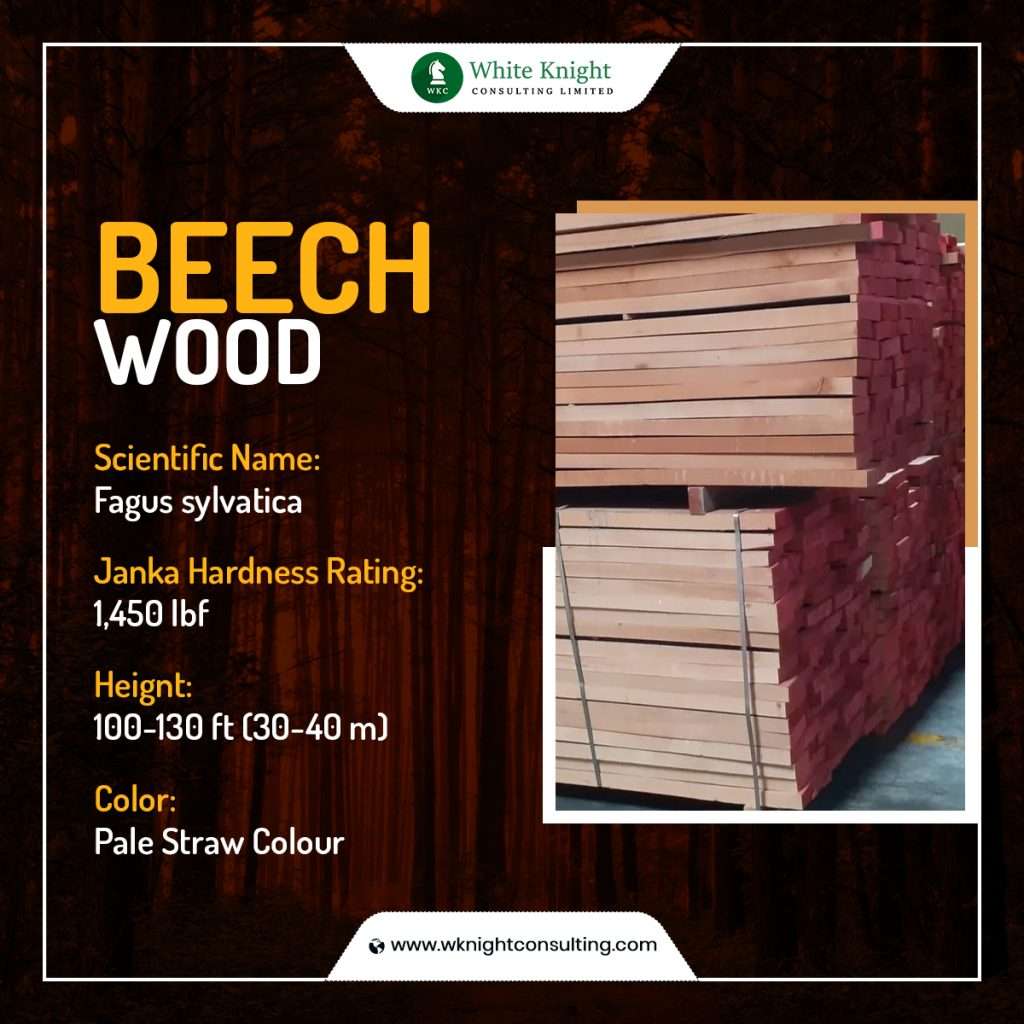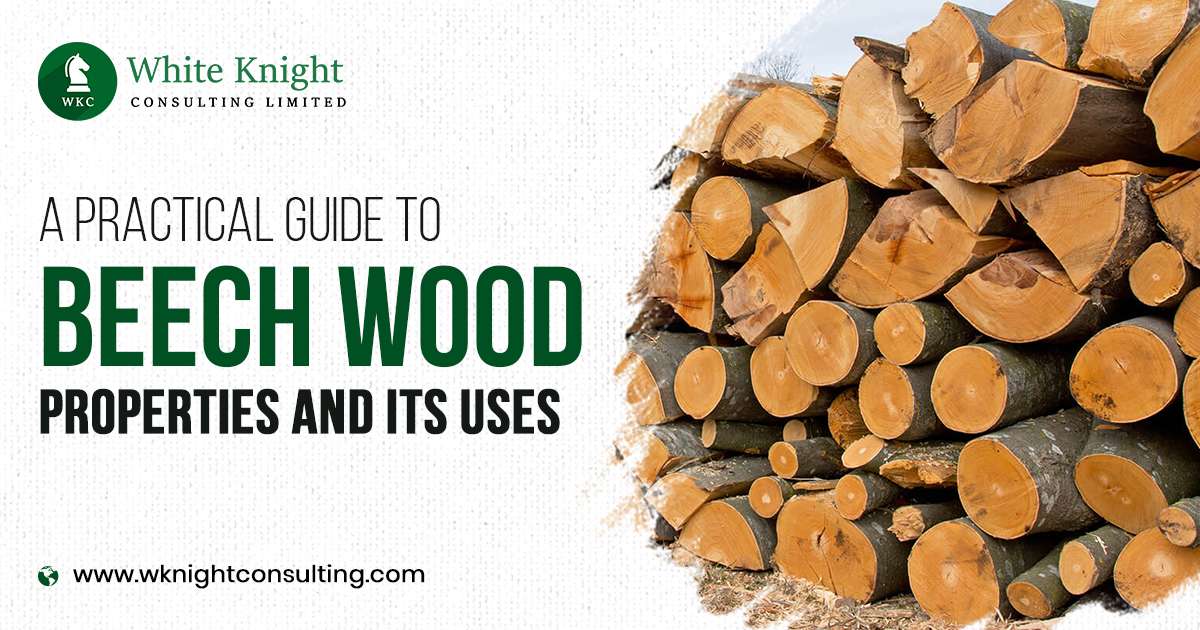Beech is a hard and strong wood that is commonly used for making furniture, plywood, sports equipment, cabinetry and tool handles, among other things.
Beech is also a very popular choice for firewood as it burns quickly, quietly and very long.
With a Janka hardness rating of 1,450 lbf, beech is one of the hardest wood species out there. However, it is almost non-durable.
Beech has many varieties that are found in Europe, Asia, and America. If you are looking to learn about the various properties and uses of beech hardwood, you’ve come to the right place.
For selecting the right hardwood timber for your project, it is crucial to be aware of the properties of wood. Here are all you need to know about beech wood properties, appearance, durability, workability, availability, and uses.
About Beech Wood

The most common type of beech – European beech – is native to Europe, specifically central and western Europe, and is found in many regions across the continent. Beech is a very popular and widespread timber in Germany. The second most popular, American beech, is found in the Eastern United States.
Beech trees are about 100-130 ft (30-40 m) tall and have a 3-5 ft (1-1.5 m) trunk diameter. The average dried weight of beech is around 710 kg/m3. It is a hard and heavy wood. At the time of felling, beech trees are about 100 to 140 years old. They can grow to a maximum age of 300+ years.
Beech is often used as a low-cost alternative to other more expensive hardwoods such as walnut, hard maple, etc. Common uses include furniture making, flooring, veneers, lumber, musical instruments, sports equipment, crates, pallets, railroad ties, and turned objects.
Beech has many species, of which the most popular are American Beech, European Beech, Copper Beech, Japanese Beech, and Tri-Color Beech.
Of all Beech types, European beech is the most commercially useful and famous. It is generally referred to simply as beech. Beech grows to a light red hue and is also called red beech. The copper beech has no commercial value. The white beech is not a species of the beech family.
Beech Wood Properties
Because of its amazing properties like strength and hardness and its cost-effectiveness, beech has been a favourite of woodworkers across Europe and America for centuries. It also bends well and is resistant to wear, which makes it suitable for heavy-traffic uses such as flooring.
Traditionally, beech trees have been very tall and wide. Natural, forests-grown beech trees can have a trunk diameter of up to 10 ft. However, most of the beech wood available today comes from plantations, where trees are much smaller.
Technical Specifications:
- Modulus of Rupture: 14,900 lbf/in2 (102.8 MPa)
- Elastic Modulus: 1,720,000 lbf/in2 (11.86 GPa)
- Crushing Strength: 7,410 lbf/in2 (51.1 MPa)
- Shrinkage: Radial: 5.5%, Tangential: 11.9%, Volumetric: 17.2%, T/R Ratio: 2.2
Beech Wood Appearance
The heartwood of American beech is light yellow or reddish-white and sometimes has a pinkish-brown hue. European beech has a pale straw colour. The sapwood is light yellowish or pale cream.
Beech is widely used for veneers. Producing veneer from beech requires the wood to be processed with steam, which causes the wood to get a darker, golden tone and a red-brown hue This is why beechwood veneers are usually darker than raw beech.
It has a straight grain and a fine or medium texture with moderate lustre.
Durability & Resistance
Beech wood is non-durable, i.e. it will perish or break easily. It is not resistant to decay, moisture or insect attack.
Beech wood doesn’t scratch or dent easily and it is also resistant to wear.
Strength & Hardness
Beech is a very hard and strong wood. The Janka rating of European beech is 1,450 lbf (6,460 N) and the hardness rating of American Beech is 1,300 lbf (5,780 N). Beech is harder than birch and oak.
Beech has high abrasion resistance, i.e. it doesn’t wear easily.
Beech Workability
Beech wood is easy to work with. It is easy to machine, cut, glue, turn, plane, drill, mill, and finish. It can be stained and polished. To bend beech wood or make veneers out of it, steam-bending is used. It is a moderately stable wood and might exhibit some movement when being worked on. It can also shrink a lot due to changes in weather conditions.
European beech is found to be a sensitizer and can sometimes cause irritation of the eyes and skin during operations.
Beech Wood Availability & Price
Beech grows in abundance in its native range of European and Eastern American countries. It is widely and readily available and is less expensive than many other hardwoods such as hard maple.
Beech is generally available as round logs, sawn timber and veneer.
Uses of Beech Wood
The only downside of beech wood is that it is non-durable, which makes it not suitable for outdoor uses.
But other than that, beech is a wonderful hardwood option for a wide range of applications, from construction and furniture making to flooring and sports equipment.
Other common uses of beech wood include furniture making, flooring, plywood, veneers, musical instruments, sports equipment, construction, cabinetry, turned objects, and small wooden items.
Because beech wood is easy to bend and turn, it is widely used for making turned objects, including toys, kitchen appliances, tools and decorative items.
Beech is also used for model building.
Beech is an extremely hard and strong wood, which makes it an excellent choice for flooring, especially in heavy-traffic commercial places. Beech flooring doesn’t wear easily. It is however prone to decay and cannot be used outside.
Beech is also very commonly used for making household furniture, chairs, bed, tables, and more. Beech furniture is very strong and heavy and lasts very long with little maintenance.
Beech hardwood is NOT suitable for exterior construction and uses such as outdoor furniture, decking or flooring.
Beech is also used for making parts of musical instruments, such as guitar bodies, drums, etc. Beech is often used as a substitute for maple when making drums.
Beech Wood Pros & Cons
Like any other commercial timber, beech wood has some drawbacks and many advantages, as follows:
Pros of Beech wood:
- Beech is an attractive wood. Its fine, uniform texture makes it smooth to look at. It also finishes well.
- Beech is also very easy to work with and machines well. It holds nails and screws well and is easy to paint, finish and polish. Steam bending produces excellent results.
- As a tough and dense wood, beech is perfect for flooring and furniture that can take heavy loads and are resistant to scratches and dents.
- It is one of the most affordable hardwoods out there. It is also easily and widely available everywhere.
- Most of the beech wood available in the market is sustainably produced.
Cons of Beech wood:
- It is not durable in terms of resistance to decay, moisture and insects. In other words, beech wood is not suitable for use in outdoor construction. It begins to rot when in contact with moisture.
- Beech is also prone to cracking and warping, especially when in contact with water.
Where to Buy Beech Wood at Wholesale Price in Europe?
Beech wood is widely and readily available all over Europe. If you live in a country outside Europe, you can easily import beech timber from a trusted hardwood supplier like White Knight Consulting Ltd.
We at White Knight Consulting Ltd have huge stocks of beech wood, timber and logs available in custom dimensions and sizes. We provide doorstep delivery in many countries, including Australia, Poland, Canada, Albania, Malaysia, and others. Contact us today for the best wholesale price for beech wood.
